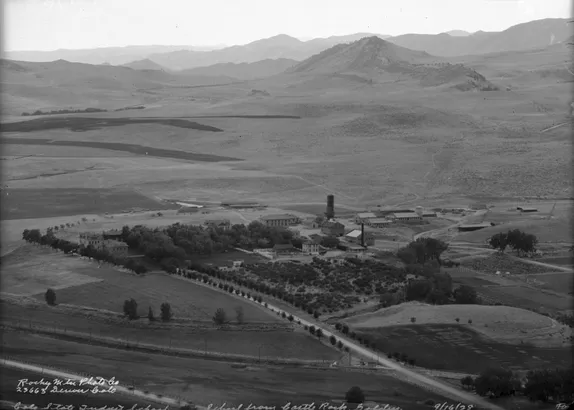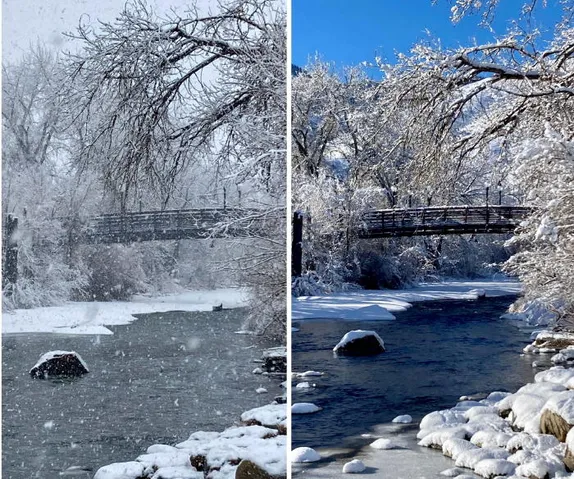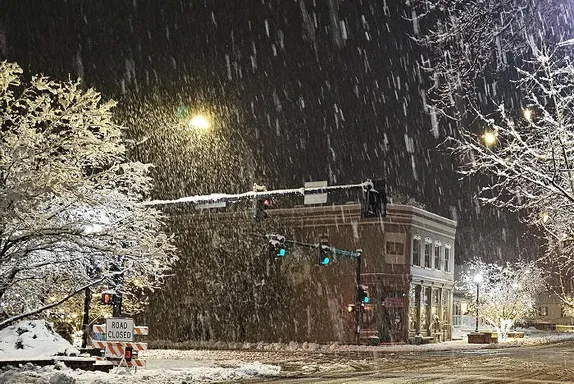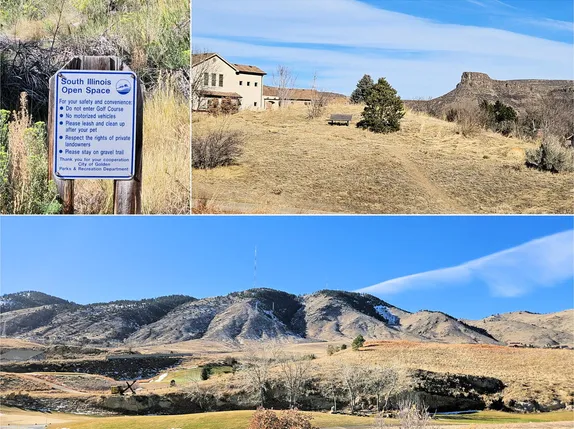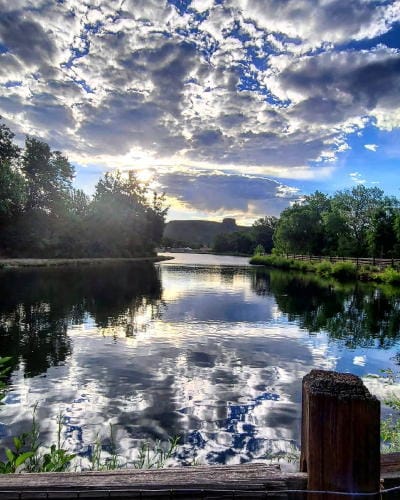
Public Health References
CDC * Colorado * Jefferson County * City of Golden
These are Friday’s stats. JCPHD updates these numbers Monday through Friday at about 3 PM, so the next update will appear in tomorrow’s post. Coronavirus report from Jeffco Public Health’s Case Summary Page:
Cases in Jeffco – Thurs: 3217 | Fri: 3253
Deaths in Jeffco – Thurs: 218 | Fri: 218
Ever Hospitalized in Jeffco – Thurs: 445 | Fri: 447 (currently 14)
Recovered – Thurs: 2744 | Fri: 2777
Known Cases in Golden – Thurs: 124 | Fri: 137
Governor Polis has instituted a statewide mask mandate when people are indoors, in public spaces (a store, library, doctor’s office, etc.). The County and City also require that we wear masks in outdoor public places. Learn more…. The Safer at Home and in the Vast, Great Outdoors protocol is in effect statewide. City and County fire restrictions are in place.
Virtual Golden
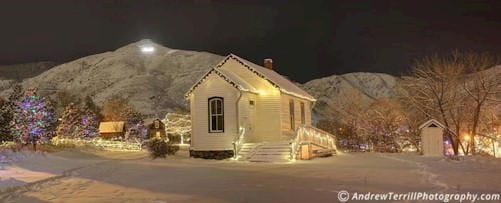
10:15-11:15AM Spanish Story Time with the Library
6:30PM Downtown Development Authority (DDA) Meeting Online
The Downtown Development Authority will consider a $5,000 grant request by the Golden History Museum. The money would be used to improve one of the cabins in the History Park, to make it more suited for interpretation and use during the summer camps. They will review the City’s COVID-19 relief programs, which have been partially funded by the DDA. They anticipate $165K, which they spent on rent relief and hunger relief during April and May, to be refunded through CARES Act (Federal) funding. They will discuss the holiday lighting contract for the next three years. The lights will cost $85K this year, $87,504 next year, and $90K in 2022. They will consider adding a special lighting attraction for this year, to provide some outdoor entertainment during the pandemic.
From the agenda: DDA will stream this meeting on the City’s website and will upload the recording of the meeting to the City’s website after the meeting. Members of the public without access to the internet may call the following phone number for listen-only mode. Please call 1-408-418-9388; access code is 146 466 7347. The public may submit comments to rfleischmann@cityofgolden.net before or during the meeting. Public comment from call-in observers will not be accepted.
8th Street Follow-Up
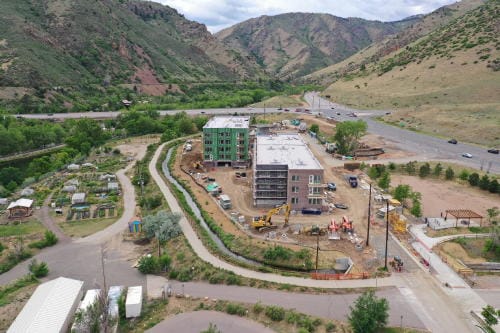
In yesterday’s History Moment, I traced the historic uses of the property at the end of 8th Street–from fertilizer plant to city dump, to gas station, to ski shop, to night club, to fine dining, to apartments and a hotel. Patrick Klein (famous for his drone photos) was kind enough to send this photo, showing the current status of construction on the property.
Golden History Moment
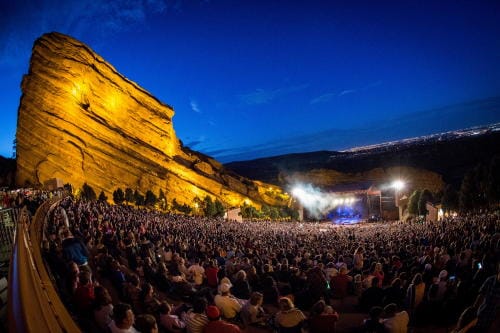
Proximity to Red Rocks Amphitheater is one of many things that make Golden groovy. I recently read that the Colorado Symphony is going to perform five concerts there this summer. Are you wondering about social distancing? Get this: they will sell only 175 tickets per performance–for an amphitheater that holds 9,525.
History of Red Rocks .
by Paul Haseman
The towering Red Rocks were discovered by an Army expedition led by Stephen Long in 1820. Centuries before this “discovery,” Red Rocks was sacred to Native American tribes such as the Utes, which inhabited this area into the 1880’s. Red Rocks Park was initially nicknamed the Garden of the Angels by Jefferson County Judge Martin Van Buren Luther on July 4, 1870. Thereafter, the first recorded ownership of Red Rocks fell to Marion Burts in 1872. After changing hands several times, in the early 1900’s, John Walker realized the acoustical qualities of Red Rocks and produced a number of concerts between 1906 and 1910 on a temporary platform. This beginning of Red Rocks as an entertainment venue was music to his ears.
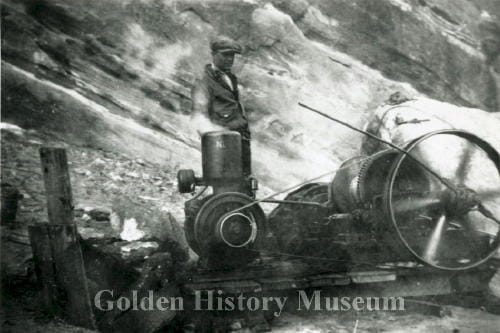
In 1934, the City of Denver purchased Red Rocks as part of its Denver Mountain Park System, which includes the Winter Park ski area and Buffalo Bill’s grave site atop nearby Lookout Mountain. George Cranmer, Manager of Denver Parks, convinced Denver’s mayor, Ben Stapleton, to pursue further entertainment and park use of Red Rocks. With a nod from the mayor, Architect Burnham Hoyt completed the design in 1936 intent on preserving the natural beauty of park area. Then aided in large part by the federal Civilian Conservation Corps (CCC)1 from its nearby CCC camp in Morrison, work began to include dynamiting several massive boulders from what’s now the audience seating and installing the seating comprised of Lyons Sandstone from the same quarry in Lyons, Colorado.
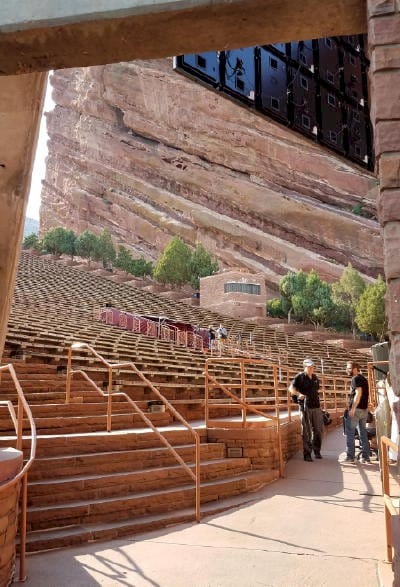
The amphitheater opened five years later on 15 June 1941 with its first performance by Metropolitan Opera soprano, Helen Jepson. Since that time Red Rocks has hosted more than 3000 performances by such artists as the Beatles, Dolly Parton, Ricky Nelson, Ray Charles, Sting, Grateful Dead, Willie Nelson and hundreds more.
In addition to the amphitheater, the surrounding 738 acres of Red Rocks Park offer deer, dinosaur history, pines and prairie flora, its geological wonders and spectacular vistas of Denver and the Great Plains. The diverse environment allows visitors to see plants, birds and animals of both the Plains and the Rockies. Over 700,000 enjoy discovering Red Rocks Park and Amphitheater each year.
Red Rocks Mountain Park and the CCC camp received National Historic Landmark status in 2015 from the National Park Service recognizing the site’s exceptional value and quality in illustrating or interpreting the heritage of the United States. At an elevation of 6,450 feet, Red Rocks seats an audience up to 9,525.
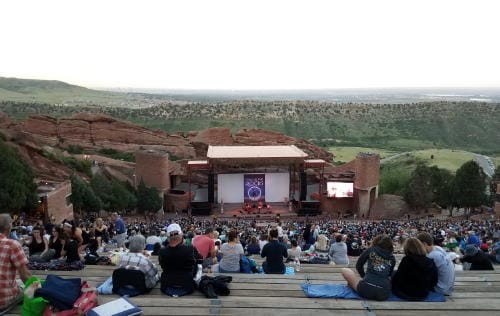
Red Rocks Amphitheater is more than an entertainments venue. It serves other community purposes. For example, 60,000 people attended the first annual Easter sunrise service held in April 1947. The Easter tradition continues to this day. Also, after Hurricane Katrina struck, the Dave Matthews Band added a fourth night at Red Rocks to raise $1.5 million for disaster relief. Good for Red Rocks.
Red Rocks Geologic Origins
The Red Rocks Amphitheater and Park is geologically part of the Fountain Formation of sedimentary sandstone formed from sediment deposited between 290 and 318 million years ago (Ma). Red Rocks has the same rock formation as Garden of the Gods in Colorado Springs and the Flatirons in Boulder. The Fountain Formation is the first and oldest sedimentary layer deposited atop the Precambrian metamorphic gneiss bedrock that comprises the Rocky Mountains. The Rockies were gradually thrust upward 66-69Ma by tectonic forces resulting in tipping the underlying sedimentary layers vertical. Majestic Red Rocks is the best evidence of this uptrust. As such, the 1000-mile Great Plains ends right here at Red Rocks. Their red color comes predominately from hematite (iron oxide) in the stone.
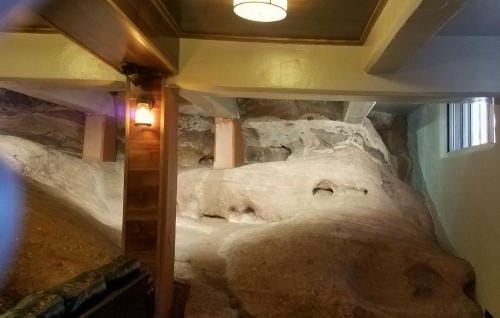
The giant rocks form the walls, stage and seating of this unique outdoor theater. The “walls” are formed by two huge sandstone monoliths; the southern monolith, that bears resemblance to a ship, is named “Ship Rock.” On the opposite side of the amphitheater stands “Creation Rock.” Both of the monoliths at 300 feet are taller than Niagara Falls. As such, Red Rocks Amphitheater is a geological phenomenon – the only naturally-occurring, acoustically perfect amphitheater in the world right here in Golden’s back yard.
1 The CCC was a public work program operated from 1933 to 1942 to provide jobs for unemployed, unmarried young men to help families during the Great Depression. It was the most popular part of President Franklin Roosevelt’s “New Deal.” The CCC provided manual labor jobs related to the conservation and development of natural resources lands owned by federal, state, and local governments such as Denver’s Red Rock Park. Over its nine years, the CCC provided jobs to 3 million men, providing them with shelter, clothing, and food, together with a wage of $30 per month – $25 of which had to be sent home to their families.

